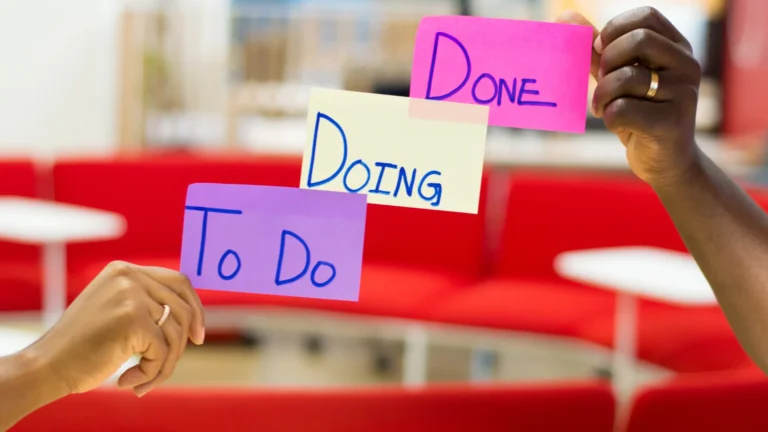Have you ever been bored to death at a presentation? We all know that! There is nothing more terrible than when the lecturer shows one slide after the other and unlovingly unwinds its contents. You can do better than that. What’s the right timing? What are the right tools, the right place? How do I find the right tone and topic? How do I focus on the audience, not the manuscript or myself?
With our tips for preparing a successful visual presentation, you will become a speaker professional and sweep your audience away.
Distinction between internal / external communication in companies
The key to the success of a presentation is that you love your topic. That might sound a bit banal. But that’s how it should be. You should be familiar with, or at least interested in, what you are talking about. Listeners notice within seconds whether you are presenting a topic that they are enthusiastic about. Because you will express your enthusiasm in your gestures, facial expressions and body language. For example, a slight smile on your face signals that you are presenting about the things you are passionate about. Why is that so important? It’s simple: your audience will only ever be as enthusiastic about a topic as you are. If you cannot warm yourself to what you are presenting, why should others do it?
In order to specifically choose the right topic, you should ask and answer the following questions:
- How can you find out which topic is best for you?
Are there examples of suitable and inappropriate topics? - Which target group of listeners am I addressing and how do I best address them?
- What should be considered during the presentation?
How do I find a good topic? - Which topic should I look for / choose and which basics and facts should I assume?
- Do I plan to interact with the audience in addition to visualization during my presentation?
- What is the right format for my presentation?
- What structure and structure should my presentation have?
How do I get off to a good start? - Is a presentation really the optimal medium for the event and the speaker compared to other media formats (e.g. video, webinar)
Internal and external communication accompany each other
Being genuinely competent is another important prerequisite for a successful presentation. Therefore, do intensive research: What’s new?
What is particularly interesting and relevant for the audience? You should know exactly what you are talking about on every point you make. So form a well-founded opinion beforehand. Your audience will notice whether you are asleep with what you are saying or not. If it detects even the smallest uncertainty, doubts quickly arise about your content. You should avoid that.
1. Why is competence so important in a presentation?
The concept of competence is often difficult to pin down. How can you be sure that you are competent? What does it mean to be competent? Is competence innate, has it already been taught in school or at university, or can it be learned from scratch? Competence is not just about being able to meet the requirements of your position, but also about how well you accept new challenges and opportunities that present themselves.
Competence is the ability to use one’s skills or knowledge effectively; Competency can be assessed based on a person’s job performance, education, and training. Competency has become an important topic in evaluating talent management as today’s business world is constantly changing due to globalization and rapid technological advances. Companies struggle to find qualified employees who have the necessary skills to keep pace with technological change while running their business efficiently.
2. What distinguishes a competent person?
“What distinguishes a competent person?” – Some say that competence is only about the ability to learn new things. Others say that it is more than that: it is about making the right decisions and being motivated to make those decisions. And maybe there is something else – like the courage to contradict or be intelligent or enjoy learning.
3. What strategies are there to demonstrate competence?
Many people know the feeling of boredom in their job. It can be difficult to motivate yourself when you feel like your work is not being appreciated or when there are no opportunities for further development. If this sounds familiar to you, consider what strategies you can use to demonstrate your competence. One way is to focus on specific business goals and find ways you can contribute to them. Another strategy could be to look for alternative career paths within the company that better suit your interests and skills. Both ways will help demonstrate your commitment to success!
5. What are the barriers to demonstrating competence?
And how can you minimize the risk of failing to demonstrate competence?
Is it a challenge to prove your skills? There are three different ways that prevent people from showing their strengths and skills. The first way is the lack of self-awareness, which leads to the fact that one does not know how to prove one’s competence in a certain area. The second type of people who struggle to show their skills is those who know what they’re good at but don’t know how to present it in a professional setting. And finally, there are people who do not reflect on the area of competence in which they are outstanding and therefore cannot show any competence. Check out this blog post for some great tips on how to overcome these obstacles so that you can show off your skills!
Internal communication has two main functions
Most presentations have a time limit. Plan your presentation so that you can fill it up with your presentations in about three quarters of the time. Make sure that you speak as slowly as possible during your presentation and do not pack too much content into your presentation. This allows your audience to follow you better. Remember that the topic you are talking about is new to your audience. So give him the time he needs to digest the contents. Allow about a quarter of the time of your previous day for questions from the audience. If there are no questions – no problem either! Then the presentation ends a little earlier.
Ask yourself:
1. What is the right time schedule for my presentation?
2. How can I structure my thoughts on a simple story to help me relax?
3. What are the right ways and means for me to deal with the excitement?
4. What do my listeners want to hear or see and what would they be most happy about so that I can safely manage that in time?
# 4 PowerPoint presentation? Yes, but right!
The question now is: can self-awareness be trained? And if so: how? There are different aspects and possibilities. You can of course try to look behind your own facade on your own. For example, there are a number of books that will guide you to decipher yourself. However, this is not really recommended, because then you usually only get superficial insights. The way to yourself works better under expert guidance. The Swiss Association for Leadership Training (SVF) offers, for example, dedicated advanced training for managers on the subject of self-awareness. That Course module self-knowledge of the Swiss Connect Academy (SCA) is part of the SVF Leadership Certificate, which enjoys the highest recognition in Switzerland.
What is advantageous in this training for managers who usually have little time anyway: It can be completed online without any problems. You learn independently of time and place and thus have the opportunity to integrate your advanced training perfectly into your everyday life. Learners benefit from a wide variety of learning materials and formats. There are varied videos, podcasts, e-readings, e-tests, e-cases, scenario-based training and much more.
Why is optimal communication in companies so important?
Your PowerPoint presentation will be all the more varied if you use different media. Emotional images, for example, have an inspiring effect. A little tip: Don’t resort to boring stock photos or standard clip art that pops up in every presentation. Get creative and use your own photos. This is not a problem in times when smartphones have high-resolution cameras and there are professional apps for image editing.
This is how you give your PowerPoint presentation an individual and very authentic touch. You can also include short videos in your presentation. That ensures variety.
The more pictures you use in your PowerPOint presentation, the better. Use images that have an emotional impact on the audience and find creative ways to incorporate your own photos too! As I said, modern smartphones have high-quality cameras with professional photo editing apps; this is a solved problem these days because there are so many different styles for every occasion with just one device.
# 6 Get familiar with the technology when making presentations
Nothing is worse than a technical breakdown in the middle of one of your lectures. Hence, you should know how the tools you are using work. For example, if you use PowerPoint, make sure you have all the shortcuts you need in mind. The better you know your way around, the more security you will feel when you step onto the podium.
It is also always better to be prepared for any technical difficulties during a presentation. It doesn’t matter which device you use, as a speaker it is important that all the tools available to me work properly and without hiccups when I need them most – especially with PowerPoint presentations, which can make the difference in an eventful speech! For this reason alone, we recommend that you familiarize yourself with all possible keyboard shortcuts so that you will never again experience such frustration if you are helplessly trying to convey important information on stage and then lose yourself in unknown commands for lack of sufficient knowledge.
Familiarize yourself with all of the keyboard shortcuts in PowerPoint. If there is an emergency during a presentation like this, it will not affect performance, as you will have acquired the necessary knowledge through research and practice.
What is effective communication in business?
You should also be familiar with the content that you are trying to get across during your presentation. Basically, you need to be able to get the core of your message across even if the power goes out. So go over the presentation over and over again so that it becomes your flesh and blood.
It is important that you are familiar with the information you are trying to convey during your presentation. You should be able to get the core message across even if the power goes out! Go over each step of your presentation so that it becomes second nature to you and no longer feels like a duty or a chore. “
Demonstrate your presentation skills: In order to be able to deliver messages effectively during a power failure, for example, you should know what information should be presented. The core of every message still has its meaning if suddenly there is no more electricity during the lecture. Therefore, always prepare before you start the presentation so that you can remember everything as if the power went out.
Please always make yourself aware that a presentation can be the most important thing you do in your work. She can decide how people think about her company and about herself. This is why it is important that you prepare down to the last detail to ensure that your message is clear and precise.
A good practice to ensure the success of any type of oral communication (including the goal: perfect presentation) would be to do a dry run beforehand and any indications of possible errors in the presentation can come to light.
# 8 The right appearance
As they say? Clothes make the man. Prepare a suitable outfit in advance – you will be the focus at least for the time of your lecture. It should be one in which you can come across as competent, but at the same time be able to move around and feel good. So nothing should scratch, pinch or pinch. That just distracts you from your presentation.
The best-dressed man or woman is not always the one who wears a suit and tie, but someone who knows how to dress for his event. You should look professional without looking like you’re trying too hard; there should be no distraction from what you are presenting with all these clothes tucked here and there! The goal in putting together an outfit is not just to find something that fits well – it also needs to instill confidence so that we can feel confident when we take the stage / hallway etc, even if that means we have ours We first have to leave the usual style preferences behind.
# 9 Check the location
If at all possible, make yourself familiar in advance with the room or location in which you will be giving your presentation, clarify important questions and ask for support if necessary.
For example: will you use a microphone or does your voice have to fill the room without aids? Does the volume have to fill all sound holes without artificial aids (microphones)? Is the room small or big?
In which place will I stand? Will it be relaxed and informal or will it be an official event? The better you know your surroundings, the fewer surprises you will encounter that could upset you.
# 10 At the end of the prep, double check that they have the characteristics of a good presentation
Does your presentation meet the characteristics of a good presentation, which are:
- The content is simply explained.
- An underlying problem has been described.
- The solution to the problem has been explained.
- The presentation concluded with a summary of the main messages and key facts.
- No foreign words or technical terms that are not generally understandable were used.
- The text kept short and clear.
Inspirational TED talks for your next presentation
Technology. Entertainment. Design (TED): Short is an acronym for the three nouns that stand for great ideas in their respective fields, and that includes anything that is technological, creative or otherwise innovative. Originally from California, but now to be found all over the world, people show new innovations at conferences like TED. These presentations are not only informative, but often also extremely entertaining: Business punk has compiled 10 of the best TED presentations:
Simon Sinek shows how great leaders inspire us to act: https://youtu.be/iE9HMudybyc
Nilofer Merchant recommends “walking talks” instead of meetings: https://youtu.be/iE9HMudybyc
Ken Robinson talks about how compliant school systems affect our creativity: https://youtu.be/iG9CE55wbtY
Why are there so few female leaders? Asks Sheryl Sandberg, COO of Facebook: https://youtu.be/18uDutylDa4
“Vulnerability is not a weakness, but a strength” says Brene Brown goes: All the power of empathy: https://www.youtube.com/watch?v=BZfirgLqK7I
Dan Pink explains where motivation comes from and how it disappears: https://www.youtube.com/watch?v=rrkrvAUbU9Y
Why do we do what we do? Tony Robbins’ legendary TED Talsk with German translation: https://www.youtube.com/watch?v=ekG-b7Z8Pw4
The Power of Introverts by Susan Cain https://www.youtube.com/watch?v=c0KYU2j0TM4
Julian Treasure shows “how you just have to be listened to”: https://www.youtube.com/watch?v=eIho2S0ZahI









